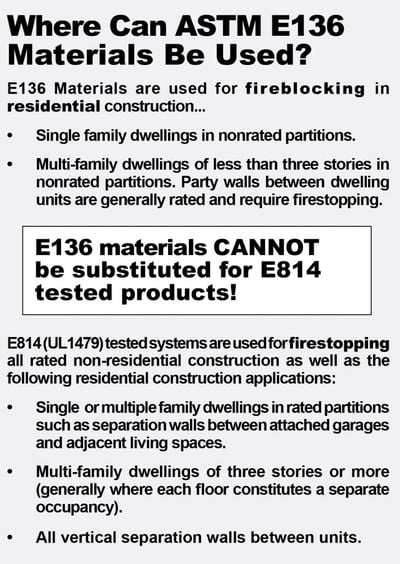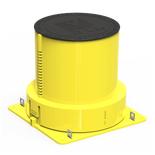Firestopping Vs. Fireblocking
Firestopping is required in multi-family frame dwellings wherever a rated separation wall or floor is required. Rated separation walls are always required between units. Rated floors are only required in in buildings of three stories or more. These are the general rules there are exceptions.
What is Fireblocking? Where the walls and ceilings do not require a rating, fireblocking is required. For the most part, the codes require openings around penetrants to be blocked or sealed using noncombustible materials. ASTM E136 is often the test standard referred to in terms of defining what materials meet this requirement. Historically, loose mineral wool fiber has been used for fireblocking.
What is ASTM E136? Fireblocking predates actual through-penetration testing standards such as ASTM E814 or UL1479. In the absence of a specific test and in consideration that the construction itself is combustible (for the most part) and nonrated, the codes simply said ‘let’s stuff something into the openings that won’t burn”. A relatively simple and inexpensive test for noncombustibility (ASTM E136) was chosen as the test method. In this test, a material (just the material itself) is placed into a small tube furnace. The pass/fail criteria relates to how much weight the specimen loses and whether its fuel content raises the air temperature in the oven.
While the test is simple to run, it is difficult to pass. All organic materials burn! Thus for the most part, materials that pass E136 must be largely comprised of inorganic materials (stone or mineral powders or fibers). Common building materials such as gypsum board as well as any paint, wall coverings, and certainly wood will not pass. Gypsum board meets noncombustibility requirements only because an exception that is made for composite materials.
E136 Sealants: Recently sealant type products have been introduced for use in these applications. Since these products must be formulated from inorganic materials, they typically are not as flexible nor as water-resistant as standard organic caulking products formulated from latex binders. Thus there are some natural limitations for these products.
Where penetrants may move through expansion and contraction, organic firestop products may be a better choice but it is important to consult the authority having jurisdiction before substituting a firestopping sealant in place of an E136 tested material.
E84 (Flame Spread and Smoke Development ONLY) also CANNOT be substituted for E814(UL1479) tested products!


























